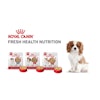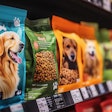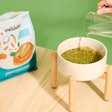Grape products get a great deal of press these days in the human food and supplement market. They are touted as beneficial for a wide array of functions from simple fruit and fiber to antioxidants that have health benefits and near-medicinal value. Grapes are, of course, the key element in wine and we hear almost daily about the benefits of modest wine consumption due to the various potent antioxidants and phytonutrients it contains.
Given the current era of humanizing all things associated with our pets, it stands to reason that grape products would find their way into the pet aisle. We do see some petfoods with grape seed extract, but grapes and raisins have been conspicuously absent. However, it's not because of any supply-side issue. There would be plenty of grape ingredients available (e.g., grape pomace, grape skins and dried fruits-raisins) to use for the purposes of supporting antioxidant vitamin fortification, functional fiber and other health attributes if grapes didn't have such bad "dog" press.
As it turns out, there are numerous veterinary case reports linking grapes, raisins and other Vitis species to vomiting, diarrhea and in some extreme cases acute renal failure and death in affected dogs. A guilty verdict has been rendered against this entire ingredient class; however, have we really seen the evidence?
According to the American Society for the Prevention of Cruelty to Animals (ASPCA) Animal Poison Control Center (APCC), grapes and raisins are toxic to dogs. They indicate that consumption of grapes and raisins can lead to vomiting, diarrhea, lethargy and polydipsia, and signs of acute renal failure, anorexia, depression, abdominal pain, tremors and hypovolemia (McNight, 2005). For affected dogs, it begins with vomiting within 24 hours of grape or raisin ingestion. Interestingly, it does not affect all dogs and has not been reported as such in other pet species (e.g., cats).
No consistent dose relationship has been identified. Reported single provocations leading to toxicities range from in excess of 3 g/kg DM (Morrow et al., 2005), 0.32 to 0.65 oz/kg body weight (Mazzaferro et al., 2004) or 21.2 mg/kg body weight (Sutton et al., 2009) depending upon the case report compilation one chooses. Said another way, these data suggest it only takes a few grapes to cause harm; so if you think about it, that is a pretty potent toxin. Yet no causative agent has been identified and the most likely culprits such as mycotoxins, pesticides, herbicides, sulfites, etc. have been eliminated as the underlying cause.
The APCC website states, "Although the toxic substance within grapes and raisins is unknown, these fruits can cause kidney failure. In pets that already have certain health problems, signs may be more dramatic." That is quite a definitive statement given the holes in the data.
Unfortunately, lacking a direct link and the shortage of any activity on the part of toxicology experts to determine a direct cause and effect, this notion of grape products as toxic has taken on more of an urban legend than a medical fact. Contrary to the case reports where data on grape and raisin consumption were derived from patient records, there does exist a battery of research in which dogs have been deliberately fed grape products in controlled studies. For most of this work, the dog was the surrogate or animal model for human coronary heart disease. The research was conducted to ascertain the response of the vasculature to clots and hardening due to various dietary interventions.
In these studies, grape juice, wine, grape seeds and grape skins were shown to have an anti-platelet effect in dogs (Demrow et al., 1995; Osman et al., 1998; Shanmuganayagam et al., 2002) when fed for long periods of time. These positive effects were not offset by vomiting, diarrhea or acute renal failure due to grape toxicity. The effective anti-platelet agents were identified as the flavonoids quercitin and rutin, but not the naturally occurring fungicide resveratrol that we tend to hear so much about.
In another unrelated report in the literature, researchers noted no ill effects when grape powder was fed to beagles at a rate of 7% or 15% of the diet for 90 days (Becci et al., 1983)-a significantly higher dose than what supposedly leads to toxicosis. Grape pomace has also been shown to be a viable functional fiber for pets (Swanson et al., 2001), a vitamin potentiator in dog diets (Wedekind et al., 2002) and helped counteract cognitive decline in old dogs (Milgram et al., 2002). However, this data gets overlooked in the veterinary literature.
So what is going on? The dose may be all important. Like onions and garlic, there may be certain elements in grapes that are beneficial to the health of the dog, but at higher dosages and lacking time for adaptation could lead to ill effects. This is a common, but misunderstood, occurrence in nutrition and pharmacology. Many of the case reports follow indiscriminate consumption of large quantities of raisins by a pet dog-a dose so proportionally large it would lead most of us to vomit and have loose stools. Interestingly, most dogs recover without any ill effects or intervention, and of course dogs that do not react negatively to grapes are never reported. So, it is really hard to get a bead on how prominent a problem this may actually be.
There is an informal survey circulating on the internet in which more than 300 respondents have indicated they feed grapes to their dogs without issue. This might suggest that there is a breed or genetic predisposition, and there might be other underlying causes that are simply exacerbated with the acute and gluttonous intake of soluble sugars, pectins and polyphenols found in grapes and raisins. Regardless, without some form of cause and effect evaluation, it is hard to say whether or not this is a real issue or something fear based. Certainly there are plenty of anecdotal and actual published results in which grape products were fed without issue.
Given grapes are lauded for their antioxidant properties; we may be missing a really wonderful group of ingredients for our pets. This is an issue that deserves to be evaluated in something other than a case study based on feeding history collected during a high-stress emergency room situation or in retrospective summaries. To do so requires some direct cause and effect feeding studies under controlled conditions, thus eliminating complicating variables in order to establish population reactivity and isolate the causative elements. While this sounds like something worthwhile, whether or not anyone will invest to answer the question is unlikely without some form of economic incentive.

















